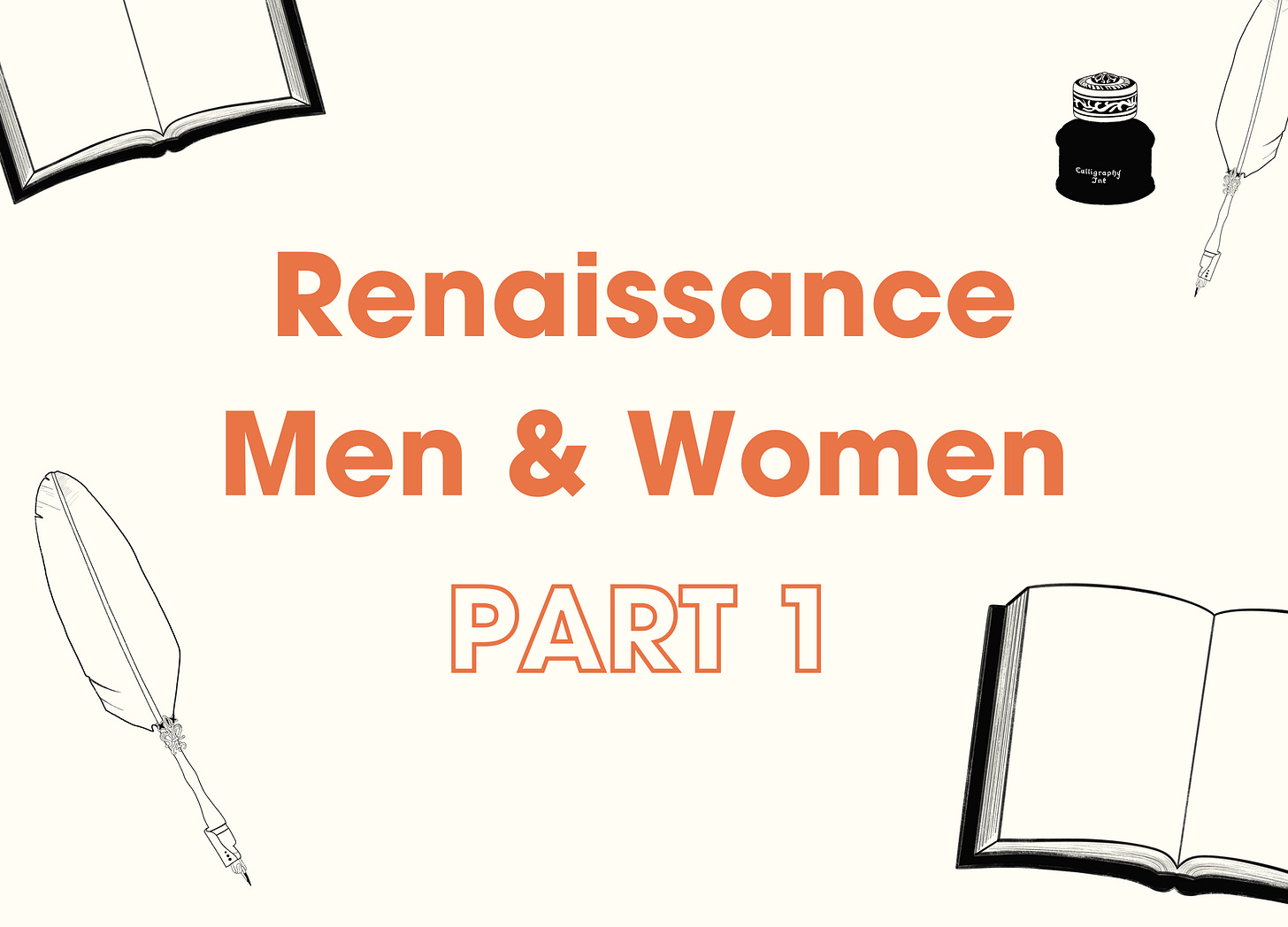Renaissance Men & Women: Part 1
An exploration of creative multi-hyphenates from past to present.
Following the dark Middle Ages, a glowing cultural resurgence occurred from the 1300s to the 1600s. This period in European civilization known as the Renaissance was characterized by a revival of “Classical scholarship and values.”1
Italy was the birthplace of humanism, a movement promoting “the idea that man was the center of his own universe, and people should embrace human achievements in education, classical arts, literature, and science.”2 This attracted an influx of Eastern scholars to the region after Constantinople’s collapse in 1453.
Florence emerged as the center of art, science, and innovation. Wealthy patrons like the Medici family, which ruled for more than 60 years, supported poets, writers, painters, sculptures, and other creatives.
Prolific inventors gained recognition and momentum as their ideas became revolutionary realities. The mechanized printing press facilitated the northern spread of literacy and Renaissance-era ideals. Furthermore, explorers ventured beyond their homelands, advancing trade routes and international finance.
Notable geniuses from the time include Sandro Botticelli (1445-1510), Rene Descartes (1466-1536), Nicolaus Copernicus (1473-1543), Galileo (1564-1642), and even William Shakespeare (1564-1616). (We’ll discuss Leonardo da Vinci, Michelangelo, and Isabella d’Este’s monumental impacts below.) Many of these inspiring pioneers studied secondary subjects—ranging from mathematics and physics to philosophy—to enhance their primary skills.
Although the Renaissance concluded in the early 1600s, its impact is still felt today. It symbolizes a strong bridge between the medieval and modern worlds.
What is a Renaissance man (or woman)?
By definition, a Renaissance man (or woman) is “a highly cultivated man (or woman) who is skilled and well-versed in many fields of knowledge, work, etc., as in the arts and sciences.”3 This term also translates to “a person who has wide interests and is expert in several areas.”4
Living from the 14th to 17th centuries is not a requirement. In fact, many creative leaders, also labeled polymaths, achieved prominence well beyond the Renaissance.
Leonardo da Vinci (1452-1519)
Professions: Painter, draughtsman, engineer, scientist, theorist, sculptor, and architect
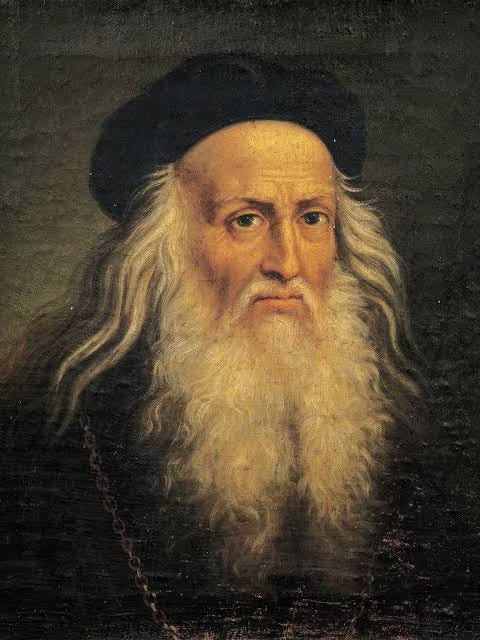
Besides fundamental reading, writing, and math, Leonardo da Vinci received no formal education. He apprenticed under sculptor and painter Andrea del Verrocchio of Florence. When he “graduated” as an independent master in 1478, da Vinci began to accept commissioned work. However, the renowned Sforza clan in Milan employed him as an engineer, painter, architect, designer of court festivals, and sculptor.
Da Vinci’s most renowned paintings are The Last Supper and Mona Lisa, but he also studied dynamic subjects including “nature, mechanics, anatomy, physics, architecture, weaponry, and more.”5 He is credited with drafting the world’s first blueprints for the bicycle, helicopter, submarine, and military tank. Da Vinci’s groundbreaking ideas, many of which he recorded in countless notebooks, persist hundreds of years later.
Isabella d’Este (1474-1539)
Professions: Patron of the arts, political figure, and humanitarian
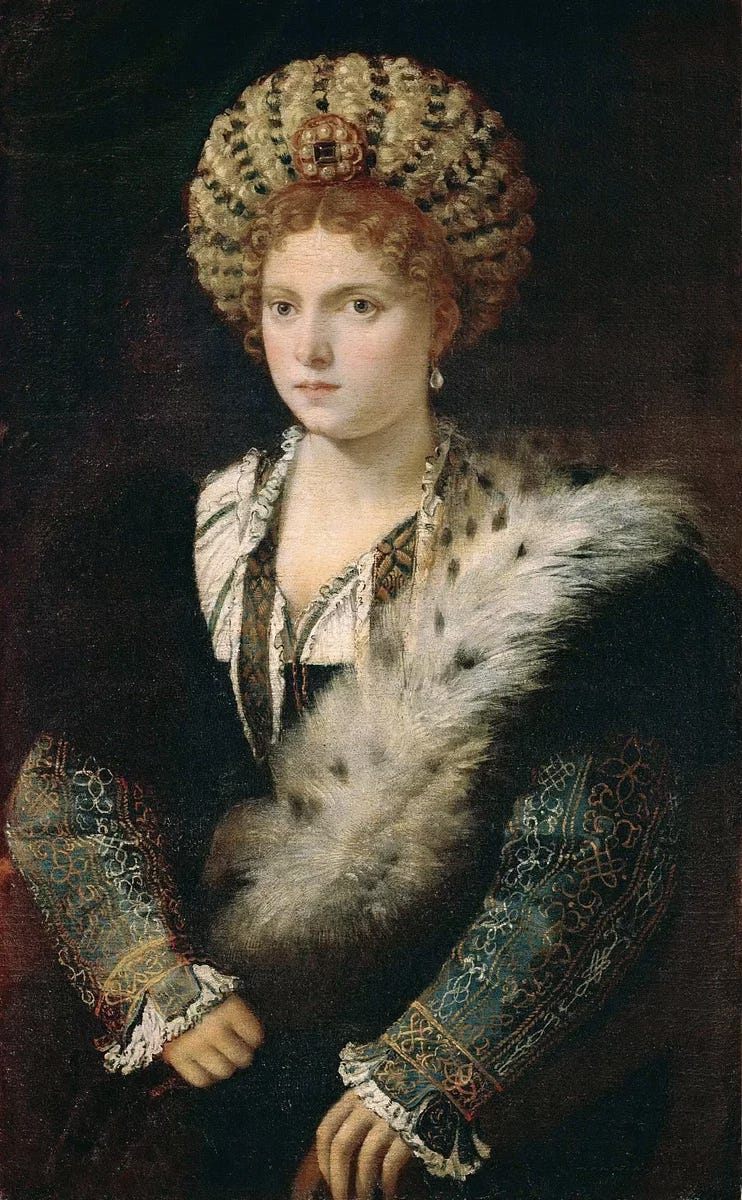
Isabella d’Este (Gonzaga) has long been regarded as “The First Lady of the Renaissance.” By the age of 16, she was fluent in Greek and Latin. She had also become a proficient singer, dancer, lute player, and debater. D’Este married in 1490 and assumed the title of marchioness. For a brief period, she served as acting regent of Mantua and skillfully negotiated on behalf of her citizens.
Although d’Este rescued her husband from prison, he resented her popularity and prevailing influence. This led her to explore Rome, where she invested in the expansion of art and culture. Upon her husband’s death and son’s ascension, Isabella d’Este elevated Mantua to the status duchy or sovereign territory.6 She sponsored painters, such as Titian and da Vinci, converted part of her palace into a museum, and founded a school for girls.
Michelangelo (1475-1564)
Professions: Sculptor, painter, architect, poet, engineer, and general contractor
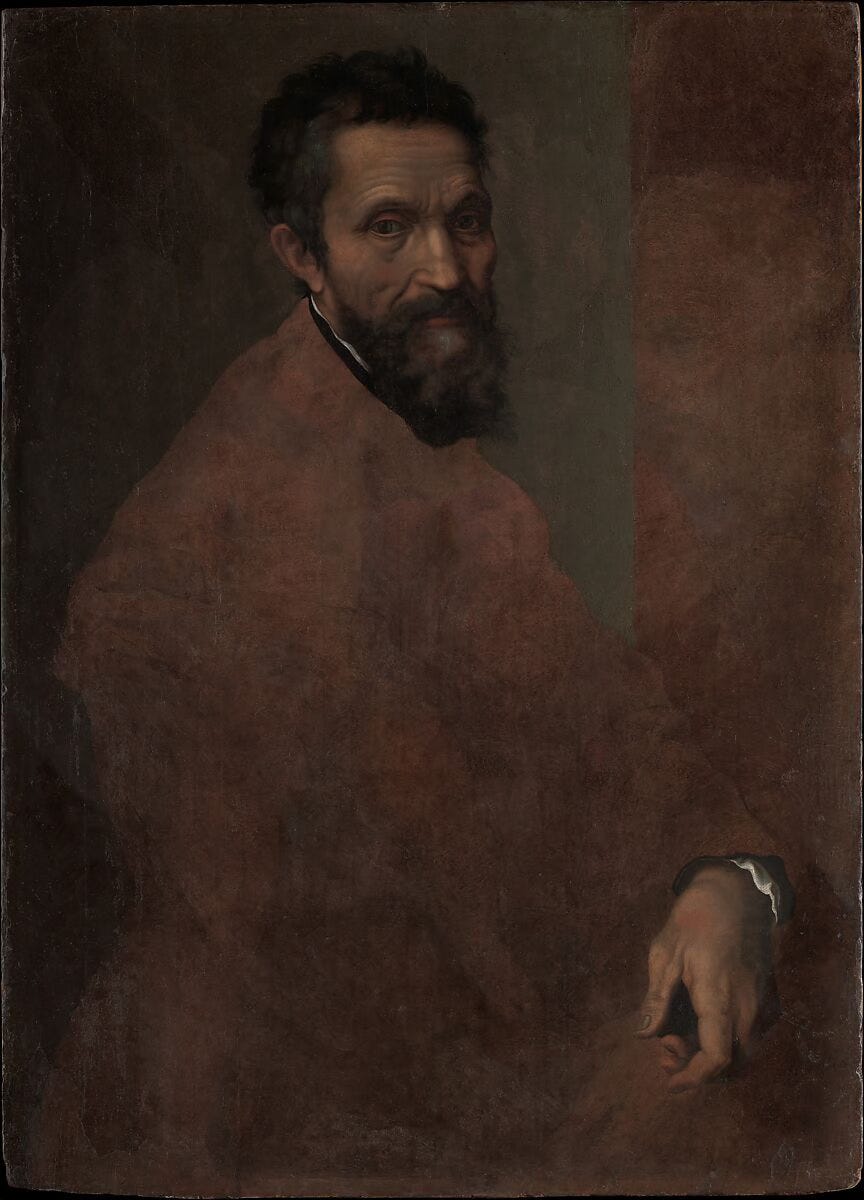
Michelangelo di Lodovico Buonarroti Simoni is best known for his preeminent artistic works during the High Renaissance. After becoming an apprentice at 13, Michelangelo gained favor with the ruler of Florence, Lorenzo de’ Medici. The political leader’s extensive collections and elite connections shaped Michelangelo’s style. House Medici eventually fell, and through a series of fortunate events (including a cardinal’s blessing), he ended up in Rome. This is where he received an influx of commissions including the emotional, lifelike sculptures Pietà and David.
Although he primarily identified as a sculptor, Michelangelo left a lasting impression with breathtaking frescoes: the Sistine Chapel ceiling and The Last Judgment. To avoid the immense strain of physical labor, he eventually moved on to architecture and designed many structures, such as the tomb of Julius II, Medici Chapel, Laurentian Library, and St. Peter’s Basilica.7
Sir Isaac Newton (1643-1727)
Professions: Mathematician, physicist, author, philosopher, astronomer, theologian, chemist, alchemist, and literary historian
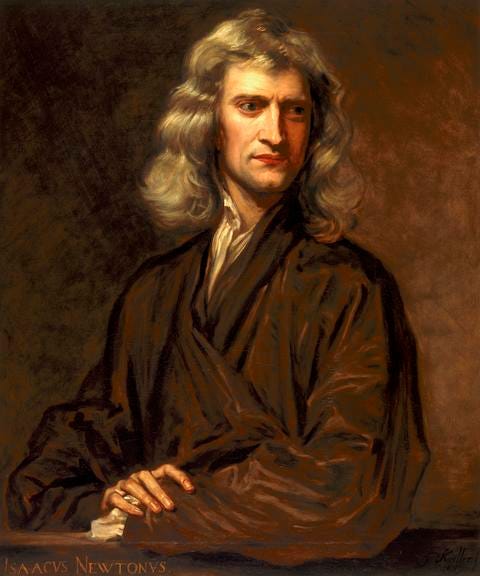
Sir Isaac Newton was transformed by the Scientific Revolution. In between studying classical curriculum, specifically Aristotle, at Cambridge, Newton discovered the works of René Descartes. The French natural philosopher’s unorthodox views on “physical reality” altered the budding young scientist’s path to truth. During the Great Plague, he was forced to sequester himself at home for two years. This marked the beginning of his intensive research and development phase. In addition to optics, Newton developed an interest in mathematics, physics, and astronomy.
Not long after graduation, he taught at the university and was appointed second Lucasian Chair. His most famous text was Newton's Philosophiae Naturalis Principia Mathematica, which outlined the three laws of motion and the universal law of gravitation. He was widely respected in intellectual circles, opening the door for him to serve as president of the Royal Society. Newton is also credited with inventing the reflecting telescope and modern Scientific Method. Most contemporary scholars agree that Isaac Newton and Gottfried Leibniz likely discovered the field of calculus independently around the same time.
Émilie du Châtelet (1706-1749)
Professions: Natural philosopher, mathematician, physicist, and translator
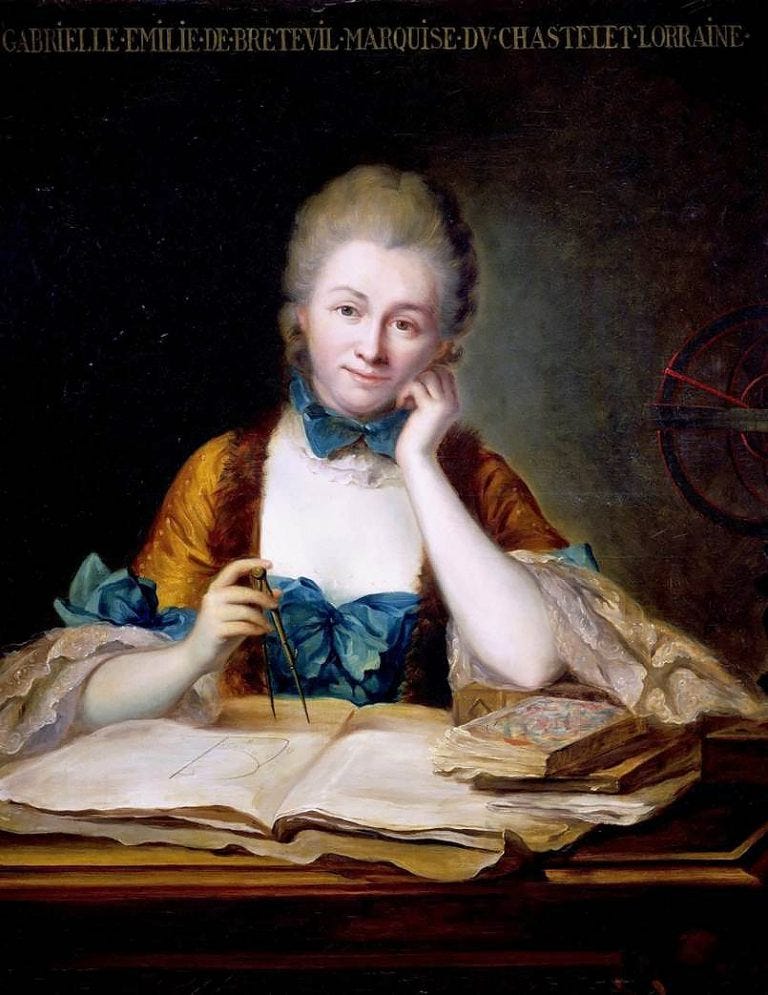
Gabrielle-Émilie Le Tonnelier de Breteuil, marquise du Châtelet was a French scientist and philosopher. Her father made sure that she was well-read and granted her the opportunities to study Latin, English, Italian, and Greek. Although married to another, she formed a profoundly intimate and intellectual partnership with Voltaire. She invited him to stay at her chateau, enabling him to avoid an arrest warrant in Paris. Together, they set up a lab, experimented, researched, and discussed various topics, namely the nature of fire.
Châtelet is known for the seminal text Institutions de physique (The Foundations of Physics) and her scientific treatises. She was also devoted to translating Sir Isaac Newton’s Principia Mathematica. Her contribution helped shift France “away from an acceptance of Cartesian physics and toward…Newtonian physics.”8 However, most of her writings on philosophy and religion were published posthumously.
Benjamin Franklin (1706-1790)
Professions: Statesperson, diplomat, scientist, inventor, philosopher, author, journalist, musician, librarian, printer, and many more!
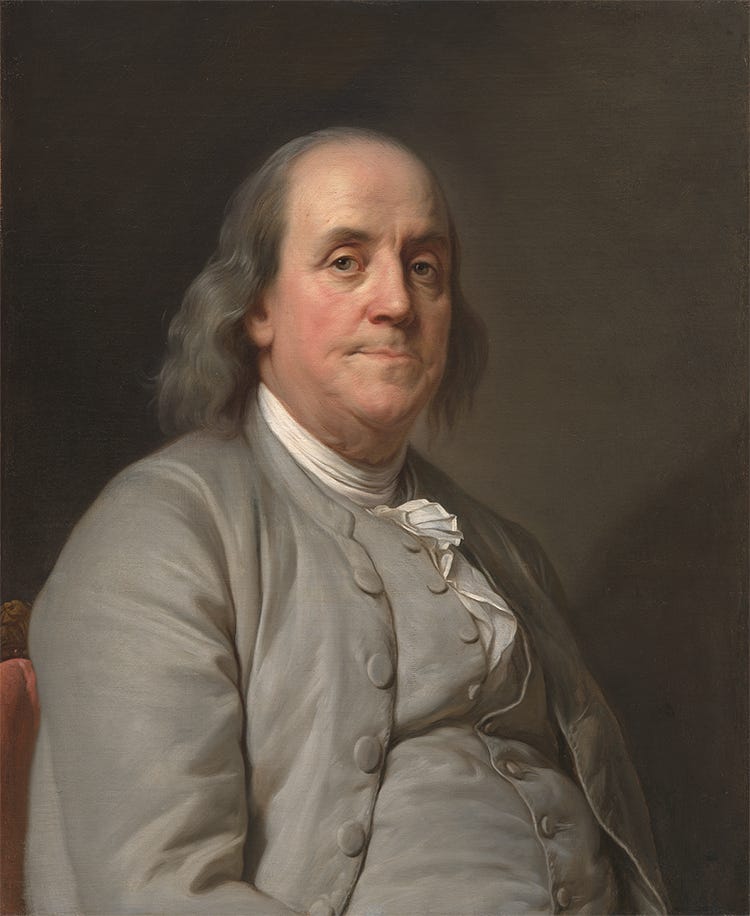
Benjamin Franklin was born in colonial Boston and raised with little formal education. His voracious appetite for books helped him become a skilled writer. Franklin’s industrious nature fueled the launch of a printing empire in Philadelphia. As his wealth increased, he invested in the city’s infrastructure and helped establish a lending library, fire company, police patrol, hospital, and college.
Amid charitable endeavors, he performed experiments and studied subjects ranging from electricity and refrigeration to ocean currents and meteorology. His most famous inventions are the lightning rod, Franklin stove, bifocal glasses, and the glass armonica. Not only did Franklin serve in the Second Continental Congress and laid the groundwork for the U.S. Post Office, but he is the only Founding Father to have signed the Declaration of Independence (1776), the Treaty of Alliance with France (1778), the Treaty of Paris (1783), and the U.S. Constitution (1787).9 These four documents were essential to the formation of the United States.
Mary Somerville (1780-1872)
Professions: Astronomer, mathematician, geographer, writer, and academic
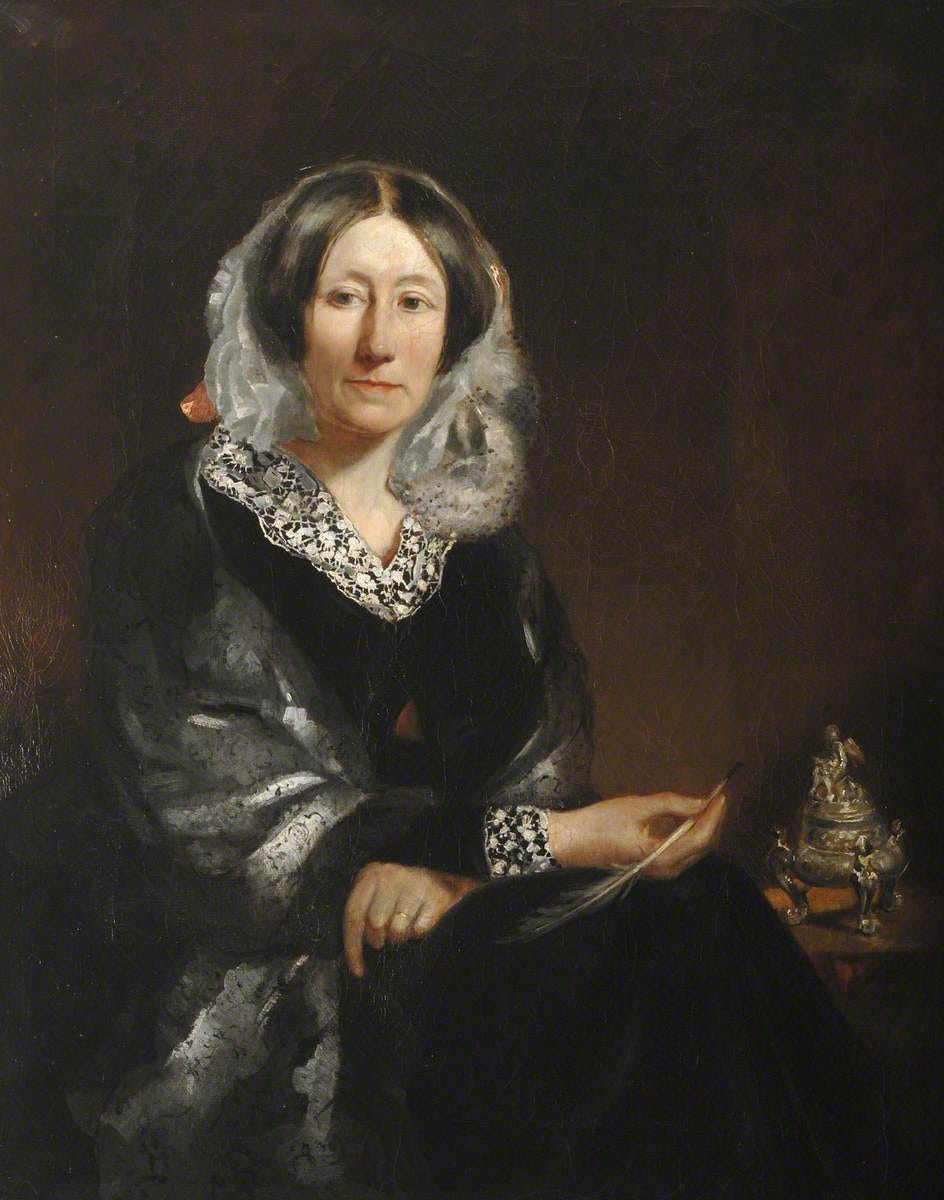
Mary Somerville was born in Scotland to an upper-middle-class family. After her mother taught her the fundamentals of literature, she attended an all-girls boarding school for 1 year. When Somerville returned to her family’s home, she spent copious hours in the library and expanded her inner world. She taught herself Latin and Greek while investigating mathematics, botany, and geology.
When she and her second husband moved to London, they befriended a group of distinguished scientists. Somerville also shared her findings with aspiring scholars like Ada Lovelace*. She wrote five books, but On the Connexion of the Physical Sciences—exploring astronomy, physics, geography, and meteorology—cemented her reputation and sold over 15,000 copies.10 Her research paved the way for other scientists—such as John Couch Adams who co-discovered Neptune—on their quests for answers. Even in the final act of her rich life, she solved complex problems every day.
*Ada Lovelace will be discussed in Part 2!
There are many more inspirational lives to study. Stay tuned for Part 2 of our discussion, in which we’ll discover 7 more Renaissance men and women.







